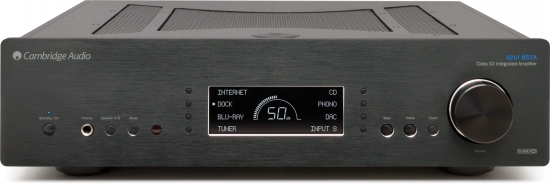Amplifier Cambridge Audio Azur 851A
Often, a company operating in a moderately public sector, trying to reward their top models are quite generous. This also applies to power - the Azur 851A is the largest among all participants of the test (120 Watts into 8 ohms per channel in stereo mode) switching and rich (again: input - the maximum amount, and two pairs of duplicated even balanced connectivity options), and the presence of a large information display. Thus, on equipment and on passport data Cambridge Audio device looks very attractive. It is equipped with two toroidal transformers - to supply pre- section and output stages, with separate windings and dual rectifiers for the two channels. For the volume manufacturer claims accurate, tailor-made potentiometer balanced design with a minimum of noise and distortion. The amplifier has TONE, allows adjustment with smooth edges with a depth of ± 10 dB at 20 Hz and ± 7,5 dB at 20 kHz.
Amplifier Cambridge Audio Azur 851A has all-aluminum body. Most of the top cover takes figured opening, closing part metal mesh (ventilation), through which can be seen quite large (13-15 cm in diameter) torus one of the transformers. The front panel is designed in the spirit of restrained manufacturability. Certain reverence towards a younger audience and kind of style theatrical sets are silver rims around the volume knob and control buttons. Already mentioned larger display in the ON state displays a lot of information is in blue color scheme and continuous operation, to my taste, attracting too much attention. Fortunately, it can be prigasit or completely disable the menu. This is done through the menu, very branched and contains a lot of options to adjust the maximum level of any input signal, the ability to assign inputs and the ability to make any input "through channel", which do not affect volume and equalizer settings. At the amplifier has a headphone output, but without a separate volume control. While the headphones off relay output by the speakers. Last curious moment - two sets of speaker terminals, allowing you to connect two pairs of speakers. They can even be used at the same time, although the nominal impedance of both pairs must not be lower than 8 ohms.
Timbre Cambridge Audio Azur 851A seemed more subtle and pointed (in any case, in conjunction with our laboratory player Bryston BCD-1, which is also little bit poor filling Voices). Decent pace, easy, forward movement in music is well planned and done without pathologies - "jumpings" jagged line or ceasing to music, rhythm neat, small rhythmic structures and clearly spelled out well. Instruments in ensembles clearly drawn, in rock - metal power easily and without problems lays on the theme components. But the general character of the sound tracks set in different ways remembered as slightly dry and slightly grainy on HF, with energetic but a bit straight attack and accents. Certain angularity sound can also be associated with our acoustics laboratory PMC OB1i, whose impedance is markedly different from the recommended 8 ohms and that is not very easy load for the amplifier. Well apparatus manifests itself in the performance of contemporary club music and other popular genres of records where a good attack and ease of separation of instruments is just a theme.




